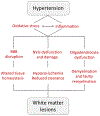Neurovascular and Cognitive Dysfunction in Hypertension
- PMID: 30920929
- PMCID: PMC6527115
- DOI: 10.1161/CIRCRESAHA.118.313260
Neurovascular and Cognitive Dysfunction in Hypertension
Abstract
Hypertension has emerged as a leading cause of age-related cognitive impairment. Long known to be associated with dementia caused by vascular factors, hypertension has more recently been linked also to Alzheimer disease-the major cause of dementia in older people. Thus, although midlife hypertension is a risk factor for late-life dementia, hypertension may also promote the neurodegenerative pathology underlying Alzheimer disease. The mechanistic bases of these harmful effects remain to be established. Hypertension is well known to alter in the structure and function of cerebral blood vessels, but how these cerebrovascular effects lead to cognitive impairment and promote Alzheimer disease pathology is not well understood. Furthermore, critical questions also concern whether treatment of hypertension prevents cognitive impairment, the blood pressure threshold for treatment, and the antihypertensive agents to be used. Recent advances in neurovascular biology, epidemiology, brain imaging, and biomarker development have started to provide new insights into these critical issues. In this review, we will examine the progress made to date, and, after a critical evaluation of the evidence, we will highlight questions still outstanding and seek to provide a path forward for future studies.
Keywords: Alzheimer’s disease; biomarkers; brain blood supply; dementia; risk factors; white matter pathology.
Figures






References
-
- Forouzanfar MH, Liu P, Roth GA, Ng M, Biryukov S, Marczak L, Alexander L, Estep K, Hassen Abate K, Akinyemiju TF, Ali R, Alvis-Guzman N, Azzopardi P, Banerjee A, Bärnighausen T, Basu A, Bekele T, Bennett DA, Biadgilign S, Catalá-López F, Feigin VL, Fernandes JC, Fischer F, Gebru AA, Gona P, Gupta R, Hankey GJ, Jonas JB, Judd SE, Khang Y-H, Khosravi A, Kim YJ, Kimokoti RW, Kokubo Y, Kolte D, Lopez A, Lotufo PA, Malekzadeh R, Melaku YA, Mensah GA, Misganaw A, Mokdad AH, Moran AE, Nawaz H, Neal B, Ngalesoni FN, Ohkubo T, Pourmalek F, Rafay A, Rai RK, Rojas-Rueda D, Sampson UK, Santos IS, Sawhney M, Schutte AE, Sepanlou SG, Shifa GT, Shiue I, Tedla BA, Thrift AG, Tonelli M, Truelsen T, Tsilimparis N, Ukwaja KN, Uthman OA, Vasankari T, Venketasubramanian N, Vlassov VV, Vos T, Westerman R, Yan LL, Yano Y, Yonemoto N, Zaki MES, Murray CJL. Global burden of hypertension and systolic blood pressure of at least 110 to 115 mm hg, 1990-2015. JAMA. 2017;317:165–118 - PubMed
-
- Scheltens P, Blennow K, Breteler MMB, De Strooper B, Frisoni GB, Salloway S, Van der Flier WM. Alzheimer’s disease. Lancet. 2016;388:505–517 - PubMed
-
- Spieth W Cardiovascular health status, age, and psychological performance. J Gerontol 1964;19:277–284 - PubMed
-
- Wilkie F, Eisdorfer C. Intelligence and blood pressure in the aged. Science. 1971;172:959–962 - PubMed
Publication types
MeSH terms
Substances
Grants and funding
LinkOut - more resources
Full Text Sources
Other Literature Sources
Medical

